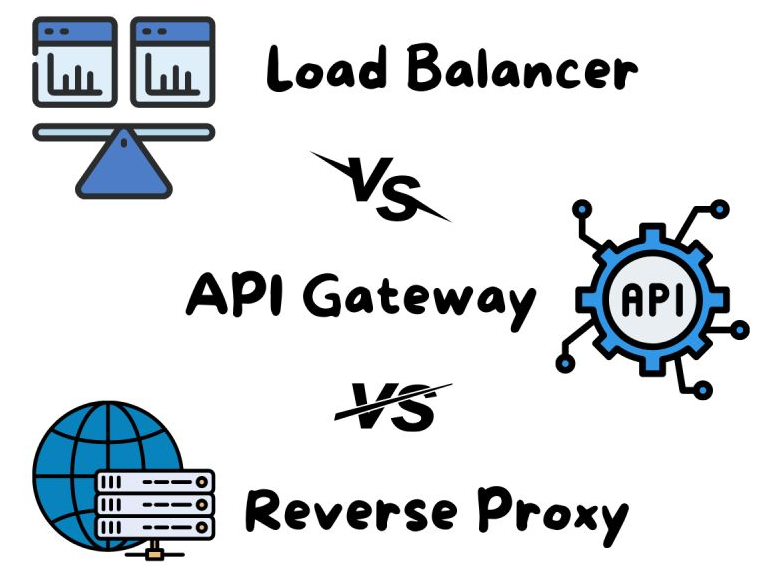
Load balancers, API gateways, and reverse proxies are all important components of web applications. They can be used to improve performance, security, and scalability.
Load balancers distribute traffic across multiple servers. This can help to improve performance by reducing the load on any one server. It can also help to improve reliability by ensuring that traffic is still routed to other servers even if one server fails.
API gateways act as a single entry point for API traffic. They can be used to provide authentication, authorization, and routing for API requests. They can also be used to provide caching and monitoring for API traffic.
Reverse proxies sit in front of web servers and forward requests to the appropriate server. They can be used to improve security by hiding the real IP addresses of web servers. They can also be used to improve performance by caching static content.
Here is a table that summarizes the key differences between load balancers, API gateways, and reverse proxies:
| Feature | Load balancer | API gateway | Reverse proxy |
|---|---|---|---|
| Primary function | Distribute traffic across multiple servers | Provide a single entry point for API traffic | Sit in front of web servers and forward requests to the appropriate server |
| Common use cases | Improve performance and reliability of web applications | Improve security, scalability, and manageability of APIs | Improve security and performance of web applications |
Load Balancers:
- Purpose:
- Load balancers distribute incoming network traffic across multiple servers (or backend resources) to improve scalability, availability, and reliability.
- Traffic Distribution:
- Load balancers use various algorithms (e.g., round-robin, least connections, weighted distribution) to distribute traffic evenly among backend servers.
- Scalability:
- Load balancers help scale applications horizontally by adding or removing backend servers dynamically based on traffic demand.
- High Availability:
- Load balancers can be configured for failover, ensuring that traffic is directed to healthy servers even if some servers fail.
- Protocols:
- They work at the transport layer (Layer 4) of the OSI model and handle TCP and UDP traffic.
API Gateways:
- Purpose:
- API gateways are intermediaries between client applications and backend services, providing a centralized point for managing, securing, and optimizing API requests.
- API Management:
- API gateways offer features like authentication, authorization, rate limiting, caching, logging, and analytics for APIs.
- Security:
- API gateways protect backend services from direct exposure to external clients and can enforce security policies and validation rules.
- Routing and Transformation:
- They can route requests to different backend services based on URL paths or headers and transform requests and responses as needed.
- Protocols:
- API gateways operate at the application layer (Layer 7) of the OSI model and handle HTTP, REST, and SOAP traffic, among others.
Reverse Proxies:
- Purpose:
- Reverse proxies are intermediaries that sit between client applications and backend servers, handling incoming requests and forwarding them to the appropriate backend based on predefined rules.
- Security and Load Balancing:
- Reverse proxies provide security benefits, such as hiding server details from external clients, performing SSL termination, and acting as a firewall. They can also perform load balancing functions.
- Caching:
- They can cache static assets or frequently requested content to reduce the load on backend servers and improve response times.
- Web Acceleration:
- Reverse proxies can optimize content delivery by compressing data and handling content negotiation for clients.
- Protocols:
- Reverse proxies operate at the application layer (Layer 7) and can handle HTTP, HTTPS, and other application-level protocols.
Use Cases:
- Load Balancers: They are primarily used to distribute network traffic across multiple servers to ensure high availability, scalability, and even load distribution. Load balancers are common in web applications and services.
- API Gateways: API gateways are used to manage, secure, and optimize APIs in microservices architectures. They play a crucial role in exposing, securing, and controlling access to APIs.
- Reverse Proxies: Reverse proxies are employed for security, performance optimization, and load balancing. They are often used in web servers, caching solutions, and as part of application delivery networks.
I’m a DevOps/SRE/DevSecOps/Cloud Expert passionate about sharing knowledge and experiences. I am working at Cotocus. I blog tech insights at DevOps School, travel stories at Holiday Landmark, stock market tips at Stocks Mantra, health and fitness guidance at My Medic Plus, product reviews at I reviewed , and SEO strategies at Wizbrand.
Please find my social handles as below;
Rajesh Kumar Personal Website
Rajesh Kumar at YOUTUBE
Rajesh Kumar at INSTAGRAM
Rajesh Kumar at X
Rajesh Kumar at FACEBOOK
Rajesh Kumar at LINKEDIN
Rajesh Kumar at PINTEREST
Rajesh Kumar at QUORA
Rajesh Kumar at WIZBRAND

 Starting: 1st of Every Month
Starting: 1st of Every Month  +91 8409492687
+91 8409492687  Contact@DevOpsSchool.com
Contact@DevOpsSchool.com
